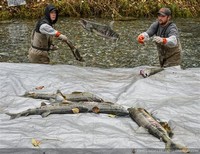Facts about Salmon
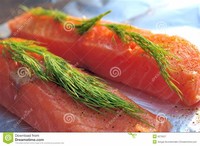
Raw salmon flesh may contain Anisakis nematodes, marine parasites that cause Anisakiasis.

Estuaries and their associated wetlands provide vital nursery areas for the salmon prior to their departure to the open ocean.
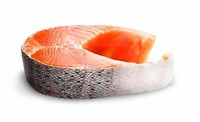
Salmon fat is about 20 percent saturated and 50 percent mono-unsaturated (Bender and Bender 2005).

Intensive salmon farming raises salmon through their full life cycle starting with fresh water hatcheries on land and moving the growing fish at the appropriate time into open net cages in the sea.

According to reports in the journal Science, farmed salmon may contain high levels of dioxins.

The wild salmon life cycle exemplifies a strong parental commitment to reproduce—even after great exertion returning upriver to the place of birth.

Lox can refer either to cold smoked salmon or to salmon cured in a brine solution (also called gravlax).

Wild salmon are found in both the Atlantic and Pacific Oceans, as well as in the Great Lakes and other landlocked lakes.

The Kamchatka Peninsula, in the Russian Far East, contains the world's greatest salmon sanctuary.

Alaska is experimenting with a variant method of fish stocking called “ocean ranching,” in which the young salmon are released into the ocean far from any wild salmon streams.

Salmon flesh is generally orange to red in color, although there are some examples of white-fleshed wild salmon.

Salmon will cross large distances and treacherous river conditions to return to spawn in the stream of their birth.

Salmon generally migrate from saltwater to freshwater to spawn.

The Ainu people of northern Japan taught dogs how to catch salmon and performed rituals to ensure a successful catch.

Another approach to increasing the harvest of salmon involves raising them in hatcheries only until they are old enough to swim to the sea, at which time they are released into rivers.

To lay her roe (egg masses), the female salmon uses her tail fin to excavate a shallow depression, called a redd.

In all species of Pacific salmon, the mature individuals die within a few days or weeks of spawning, a trait known as semelparity.

Salmon can make amazing journeys, sometimes moving hundreds of miles upstream against strong currents and rapids to reproduce.
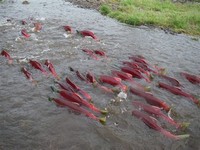
The precise method salmon use to navigate has not been entirely established, though their keen sense of smell is certainly involved.
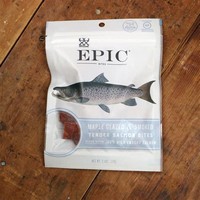
Salmon has long been at the heart of the culture and livelihood of coastal dwellers.

Salmon farming is very important in Norway, Sweden, Scotland, Canada, and Chile.

Columbia River salmon levels are estimated now to be less than three percent of what they were when Lewis and Clark arrived at the river in 1805 (McDermott 2007).
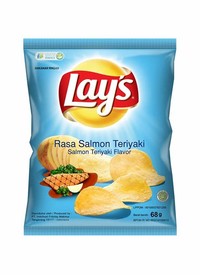
Salmon lay between 2,500 and 7,000 eggs depending on the particular species and size of the fish (Wisnia 1997).
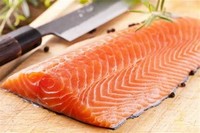
Wild salmon get these carotenoids from eating krill and other tiny shellfish.

Departments of several governments as well as several NGOs are sharing and participating in documentation efforts aimed toward developing strategies for relieving the stress on the salmon populations.

Wild salmon population levels are of concern in the Atlantic and in some parts of the Pacific, though in northern British Columbia and Alaska, stocks are still abundant.

Freshwater streams and estuaries provide important habitats for many salmon species, which feed on terrestrial and aquatic insects, amphipods, and other crustaceans while young, and primarily on other fish when older.

Salmon aquaculture, or salmon farming, is a major economic contributor to the world production of farmed fin-fish, representing over one billion U.S. dollars annually.

At this time, all salmon change from the silvery blue of a fresh-run fish from the sea to a darker color.

PCB (polychlorinated biphenyl) levels may be up to eight times higher in farmed salmon than in wild salmon, and Omega-3 content in farmed salmon may also be lower than in wild caught individuals.

Fish hatcheries have been under development at least since the mid-1800s and Scandinavian efforts to enhance salmon runs with fish raised in hatcheries dates back to the early decades of the twentieth century.

The various species of salmon have many names, and varying behaviors.

The Pacific salmon, in particular, is noteworthy because its expenditure of energy to complete reproduction is total as the mature individuals die within a few days or weeks of spawning.

Salmon comprise several species, mainly in the Oncorhynchus genus, but also including the Atlantic salmon (Salmo salar).

Mortality of salmon in the early life stages is usually high due to natural predation.

Chinook and sockeye salmon from central Idaho, for example, travel over nine hundred miles and climb to elevations of 6,500 feet in order to return to spawn.
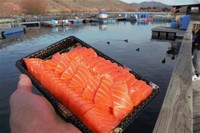
Other countries with significant salmon farming industries include Russia, Tasmania, Australia, the United Kingdom, and the United States.

In Alaska, salmon have also been known to colonize new streams, which are often created when a glacier melts.

A study published in the Archives of Internal Medicine suggests that eating high fiber foods, such as legumes, helps prevent heart disease (Bazzano et al.

Consequently, as the number of farmed salmon increase, so does the demand for other fish to feed the salmon.

Salmon is an exceptionally rich source of vitamin B12, a rich source of niacin, vitamin B6, copper, and selenium, and a good source of vitamin B1 (Bender and Bender 2005).

When it is time for the salmon to spawn, they return to where they were released and where fishermen can then catch them.

The salmons spend one to five years (depending on the species) in the open ocean, where they become sexually mature.

Sometimes the term "salmon" is used to refer more generally to any member of Salmonidae, the salmon family.

Canned salmon in the U.S. is usually wild Pacific catch, though some farmed salmon is available in canned form.

The natural color of salmon results from carotenoid pigments, largely astaxanthin (E161j), in the flesh.
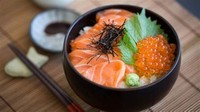
Salmon and salmon roe have only recently come into use in making sashimi (raw fish) and sushi (raw fish together with rice and other foods).
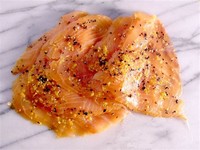
Smoked salmon is another popular preparation method and can either be hot or cold smoked.

Of the several varieties of North American salmon, all but one are found off the Pacific coast and most (about 90 percent) come from Alaskan waters (Herbst 2001).

Atlantic salmon can spawn more than once (iteroparity), though post-spawning mortality is still quite high in that species.

At this time, all salmon change from the silvery blue of a fresh-run fish from the sea to a darker color.
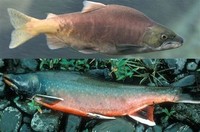
Salmon are large, predatory fish, feeding mainly on other smaller fish.

The age of a salmon can be deduced from the growth rings on its scales, examined under the microscope.

Salmonidae is a family of ray-finned fish, the only living family of the order Salmoniformes.



